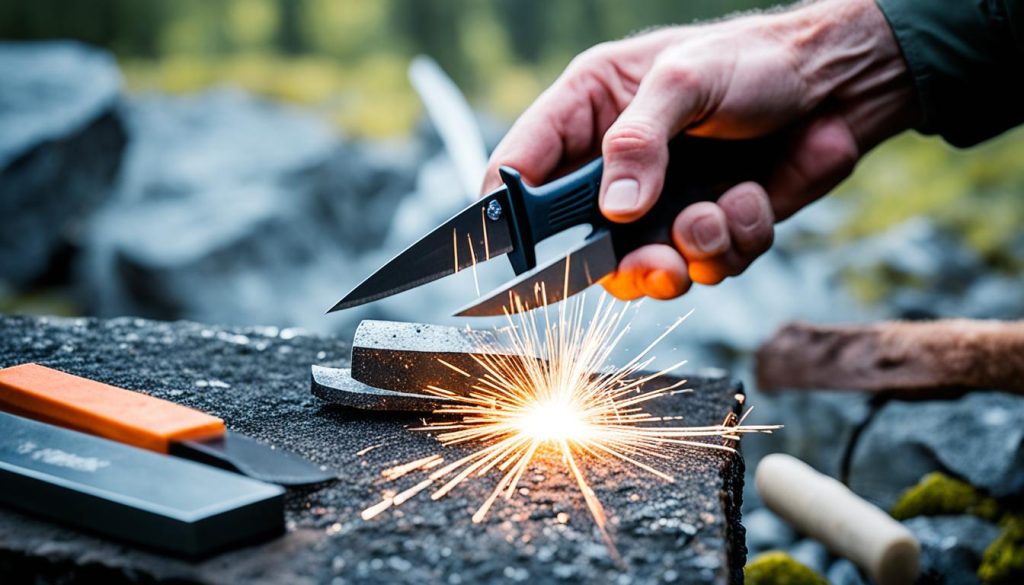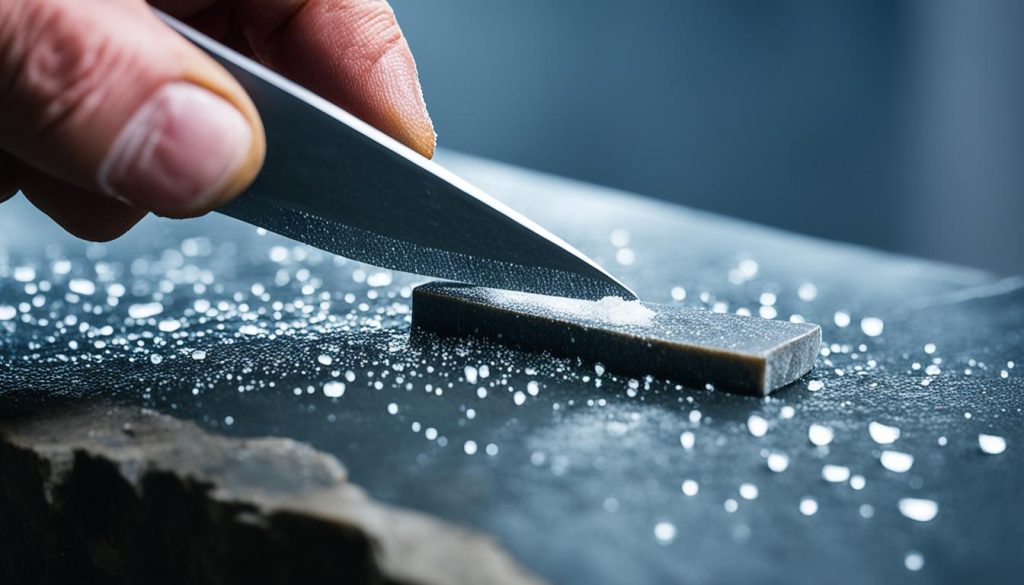Did you know that inadequate maintenance of wilderness survival tools can significantly increase the risks during outdoor expeditions?
When it comes to surviving in the wild, having reliable and well-maintained tools is paramount. Whether you’re camping, hiking, or simply exploring nature, your tools play a vital role in your safety and survival. By neglecting regular maintenance, you could find yourself in a dangerous situation where your tools fail to perform their intended functions effectively.
To ensure your wilderness survival tools are always ready for action, it’s crucial to prioritize maintenance and upkeep. From sharpening blades to cleaning and storing equipment properly, following maintenance tips will help extend the lifespan of your tools and enhance your overall wilderness experience.
Key Takeaways:
- Regularly sharpen blades to maintain their effectiveness and cutting power.
- Clean tools after each use to remove dirt, debris, and moisture.
- Store tools in a dry and secure location to prevent rust and damage.
- Inspect tool handles for cracks or damage and repair or replace as necessary.
- Lubricate moving parts and hinges to ensure smooth operation.
Essential Survival Tool Maintenance Tips
Proper care and maintenance of your wilderness survival tools are crucial for their reliability and effectiveness. By following these essential maintenance tips, you can ensure that your tools stay sharp, well-maintained, and ready for any outdoor adventure.
Keeping Tools Sharp
Regularly sharpening the blades of your tools is essential to maintain their cutting power and effectiveness. A sharp tool will make tasks easier and prevent accidents caused by dull blades. Consider investing in a high-quality sharpening stone or honing rod to keep your blades in top condition.
Tool Care Essentials
- Clean your tools after each use to remove dirt, debris, and moisture. This will help prevent rust and prolong the lifespan of your equipment.
- Store your tools in a dry and secure location to protect them from environmental damage. A sturdy toolbox or storage bag can help keep your tools organized and safe.
- Regularly inspect the handles of your tools for cracks or damage. If you notice any issues, repair or replace them as necessary to ensure safe and comfortable use.
- Lubricate the moving parts and hinges of your tools to maintain smooth operation. This will prevent them from getting stuck or seizing up when you need them most.
- Check for any loose screws or fasteners on your tools and tighten them to keep everything secure. Loose parts can affect the performance and safety of your equipment.
Maintenance Checklist
Following a maintenance checklist can help you stay organized and ensure that you don’t overlook any important tasks. Here are some items to include on your wilderness survival tool maintenance checklist:
- Sharpen blades
- Clean tools
- Store in a dry location
- Inspect handles
- Lubricate moving parts
- Check for loose screws
- Follow manufacturer’s guidelines
By regularly maintaining and caring for your wilderness survival tools, you can rely on them when you need them most. Stay prepared and ensure your tools are ready for any outdoor challenge.
Knife Maintenance Tips for Wilderness Survival
When it comes to wilderness survival, a properly maintained knife is an essential tool. Knife maintenance not only ensures the longevity of the blade but also guarantees its optimal performance when you need it most. Follow these knife maintenance tips to keep your blade sharp and ready for any outdoor adventure.
1. Sharpening Techniques
Regularly sharpening your knife blade is key to maintaining its effectiveness. Utilize a sharpening stone or a honing rod to create a sharp edge. Hold the blade at a 20-degree angle and swipe it against the stone or rod in controlled, consistent motions. Remember to evenly sharpen both sides of the blade for a balanced edge.
2. Blade Care
Keeping your knife blade in good condition requires routine care. One crucial step is regularly oiling the blade to prevent rust and corrosion. Apply a small amount of lubricating oil to a clean cloth and wipe it over the blade’s surface, paying extra attention to the cutting edge. This protective coating will help maintain the blade’s integrity and prevent damage.
3. Proper Usage
Avoid using your knife on hard surfaces to prevent dulling the blade. Hard materials, such as metal or stone, can quickly wear down the cutting edge. Instead, focus on using your knife on appropriate materials like wood or soft materials that won’t compromise its sharpness.
4. Thorough Cleaning
After each use, it’s crucial to clean your knife thoroughly to remove dirt, debris, and residue. Starting with warm water and mild soap, gently scrub the blade using a soft-bristled brush or cloth. Pay attention to the handle and any hard-to-reach areas. Rinse the knife with clean water and dry it thoroughly to prevent moisture-related issues.
5. Safe Storage
Storing your knife properly is essential for both maintenance and safety. Always keep your knife in a sheath or protective cover to prevent accidental injuries. The sheath will not only secure the blade but also protect it from external elements that may cause damage. Choose a storage location away from moisture and extreme temperatures to maintain its longevity.
6. Handle Inspection
Regularly inspect the knife handle for any signs of wear or damage. Check for cracks, splinters, loose fittings, or any other issues that may compromise your grip and control. If you spot any problems, repair or replace the handle promptly to ensure safe and efficient knife usage.
Maintaining your knife is essential for wilderness survival. By following these knife maintenance tips, you can rest assured that your blade remains reliable, sharp, and ready for any challenges that come your way.
| Knife Maintenance Tips for Wilderness Survival | Benefits |
|---|---|
| Regularly sharpen your knife blade | Ensures optimal cutting performance |
| Oil the blade to prevent rust | Increases longevity and durability |
| Avoid using the knife on hard surfaces | Maintains blade sharpness |
| Clean the knife thoroughly after each use | Prevents dirt and residue buildup |
| Store the knife in a sheath or protective cover | Ensures safety and protection |
| Inspect the handle for wear or damage | Maintains grip and control |
Maintaining Fire Starters and Cordage
When it comes to wilderness survival, fire starters and cordage are two essential tools that can make a significant difference in your outdoor experience. To ensure their effectiveness, it’s important to properly maintain and care for these crucial items. Here are some key tips for fire starter maintenance and cordage care:
Fire Starter Maintenance
To keep your fire starters in optimal condition:
- Store them in waterproof containers to protect them from moisture and ensure their functionality when needed.
- Regularly test the fire starters to ensure they are still able to produce a spark or flame when ignited.
Cordage Care
Proper care of your cordage is vital for its strength and durability:
- Replace worn or damaged cords with new ones to maintain their integrity and prevent accidents or failures.
- Store cordage in a dry and secure location to protect it from rotting or weakening caused by exposure to moisture.
Additionally, it’s beneficial to practice different fire-starting techniques to ensure proficiency in emergency situations. Familiarize yourself with alternative methods such as using natural tinder, fire plow, or bow drill to increase your chances of successfully starting a fire even without a fire starter.
Remember, fire starters and cordage are vital components of your wilderness survival kit. By following these maintenance tips, you’ll be well-prepared and equipped to handle various outdoor challenges.
| Fire Starter | Maintenance |
|---|---|
| Waterproof Containers | Store fire starters in waterproof containers to protect them from moisture and ensure their functionality when needed. |
| Regular Testing | Regularly test fire starters to ensure they are still able to produce a spark or flame when ignited. |
| Cordage | Care |
|---|---|
| Replacement | Replace worn or damaged cords with new ones to maintain their integrity and prevent accidents or failures. |
| Storage | Store cordage in a dry and secure location to protect it from rotting or weakening caused by exposure to moisture. |
Water Purification System Maintenance
Proper maintenance of your water purification system is essential to ensure a supply of clean and safe drinking water during your outdoor adventures. By following these maintenance tips, you can extend the lifespan of your system and ensure its effectiveness in filtering out contaminants:
- Clean and sanitize regularly: Regularly clean and sanitize your water purification system to remove any build-up or contaminants. Use mild soap and warm water to clean the components, ensuring thorough rinsing before use.
- Check expiration dates: Always check the expiration date of your water purification tablets and replace them as necessary. Expired tablets may not be as effective in removing bacteria and pathogens from water.
- Carry backup options: As a backup to your primary water purification system, consider carrying additional water purification tablets or a portable water filter. This ensures you have alternative methods for purifying water in case of emergencies.
- Test effectiveness: Before embarking on any outdoor adventure, test the effectiveness of your water purification system. This can be done by filtering water from a known source and conducting a simple water quality test to ensure its efficiency.
- Follow manufacturer’s instructions: Always refer to the manufacturer’s instructions for proper storage and maintenance of your water purification equipment. Each system may have specific care requirements, so following these instructions will help maximize its performance.
By diligently caring for your water purification system and having backup options available, you can ensure a continuous supply of safe drinking water throughout your wilderness journeys.
Maintaining Tools for Shelter Building
When it comes to shelter building in the wilderness, having reliable and well-maintained tools is essential. From saws and axes to folding tools, taking proper care of your shelter building tools ensures their longevity and peak performance. Here are some essential maintenance tips and tool care essentials to keep in mind:
- Inspect tools regularly: Before each use, inspect your tools for any signs of damage or wear. Check the blades, handles, and moving parts to ensure everything is in good condition.
- Clean after use: After completing your shelter building tasks, make sure to clean your tools thoroughly. Remove any sap, dirt, or debris that can affect their performance or cause corrosion.
- Sharpen blades regularly: Properly sharpened blades are essential for efficient cutting. Regularly sharpen the blades of your tools using the appropriate sharpening tools or techniques.
- Store in a dry and secure location: Moisture and exposure to elements can lead to rust and degradation. Store your shelter building tools in a dry and secure location to protect them from damage and ensure their longevity.
- Lubricate hinges and moving parts: For folding tools, make sure to lubricate hinges and moving parts to keep them functioning properly. This will help maintain their ease of use and prevent rust.
By following this maintenance checklist and tool care essentials, you can ensure that your shelter building tools are always ready for your wilderness adventures. Remember, well-maintained tools are the key to efficient and successful shelter building.
Expert Tip:
Investing in high-quality tools from reputable brands can significantly impact their durability and performance. Look for tools specifically designed for shelter building to ensure they can withstand the demands of the wilderness.
Foraging Tools Maintenance for Wilderness Survival
In the wild, having properly maintained foraging tools is essential for a successful and safe experience. From knives to gathering baskets, taking care of your tools ensures their longevity, efficiency, and your overall foraging success. Here are some maintenance tips and best practices to keep your foraging tools in excellent condition:
- Clean after each use: After foraging, clean your knives and gathering baskets thoroughly to remove any plant residues or debris. This not only keeps them in good condition but also prevents the transfer of unwanted materials to your next foraging session.
- Inspect and sharpen blades: Regularly inspect the blades of your knives and pruning shears for any signs of dullness or damage. Sharpen them using a sharpening stone or honing rod to maintain their sharpness and ensure precise cutting.
- Proper storage: Store your foraging tools in a clean and dry environment to prevent rust or damage. Consider using a protective sheath or case for knives to prevent accidents and maintain their edge.
- Replace worn or damaged tools: Over time, foraging tools may show signs of wear or damage. It is important to replace worn or damaged tools with new ones to maintain efficiency and safety during your foraging activities.
By following these maintenance tips and practices, you can enhance the performance and lifespan of your foraging tools, allowing you to forage with confidence and efficiency in the wilderness.
For more information on wilderness survival and outdoor gear, check out this source.
Conclusion
Proper maintenance of wilderness survival tools is essential for ensuring their reliability and functionality during outdoor adventures. By following best practices for survival tool maintenance and outdoor gear care, you can extend the lifespan of your tools and enhance your overall wilderness survival experience.
To keep your tools in top condition, remember to regularly inspect, clean, sharpen, and store them properly. Regular inspections help identify any signs of wear or damage, allowing you to address them promptly. Cleaning your tools after each use removes dirt, debris, and moisture that can affect their performance and longevity.
Sharpening your knives and other cutting tools ensures their effectiveness, while proper storage in a dry and secure location protects them from rust and damage. By following these maintenance tips, you can be confident that your tools will be ready for any situation you may encounter in the wilderness.
Check out this comprehensive guide for more information on survival tool maintenance and best practices, which will help you make the most of your outdoor adventures.



